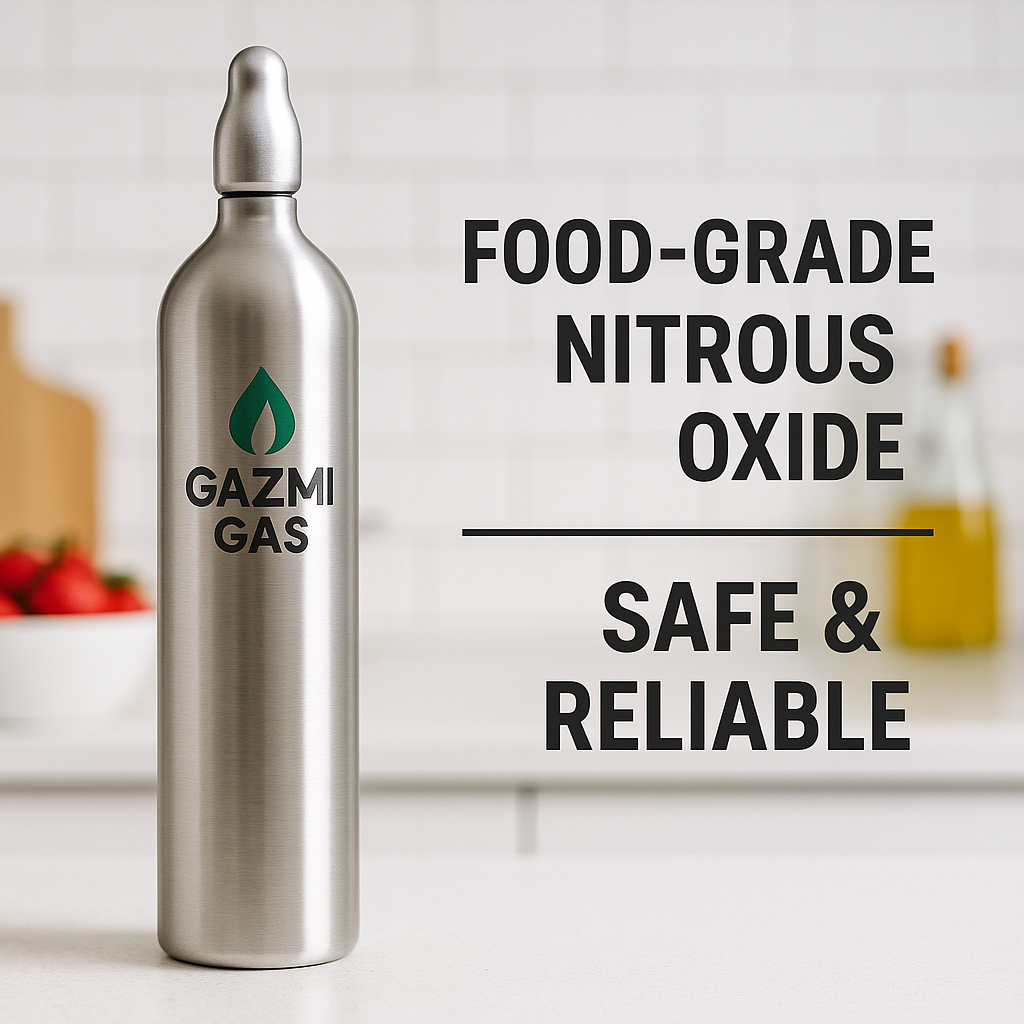
Food-Grade Nitrous Oxide Cylinder — Features & Safety Facts
Share
A professional, kitchen-focused guide to food-grade N2O cylinders: what “food-grade” means, how cylinders are engineered, and the essentials for safe handling and consistent results in culinary applications.
What “Food-Grade” Really Means Quality & Purity
“Food-grade” refers to gas purity and packaging standards suitable for culinary use. In practice, this supports clean flavor expression, predictable foams, and consistent dispensing pressure when used with compatible kitchen equipment.
- Tight purity expectations: Controlled contaminants help maintain stable flavor and texture outcomes.
- Consistent performance: Pressure delivery tailored for culinary routines like whipped cream and coffee foam.
- Packaging fit for kitchens: Cylinders designed for routine back-of-house handling when used as directed.
Engineering & Construction
Pressure Integrity
Cylinders are built from robust steel or aluminum and undergo processes designed to support high-pressure containment under normal operating conditions. Threaded interfaces and valve components are manufactured for repeatable attachment with compatible dispensers.
Valve & Interface Design
Interfaces are machined for precise sealing when used as intended. Always attach and detach in accordance with the dispenser manufacturer’s instructions to help maintain seal integrity over time.
Surface & Clean Handling
Exterior finishes support wipe-down cleaning protocols typical in professional kitchens. Avoid abrasive pads on labeling or regulatory markings to keep information legible.
Lifecycle Awareness
Incorporate periodic checks for dents, corrosion, or thread wear. Retire any unit that shows visible damage or does not seat properly.
At-a-Glance Specs
| Intended Use | Culinary applications (e.g., whipped cream, coffee foam, modern dessert textures) with compatible equipment. |
|---|---|
| Material | Steel or aluminum cylinder body; precision-machined valve and threads. |
| Dispensing Behavior | Consistent pressure delivery when used as directed with maintained equipment. |
| Storage Orientation | Upright only, in a cool, dry, well-ventilated space away from heat and direct sunlight. |
| Handling Notes | Attach/detach per equipment instructions; inspect threads and seals; keep out of reach of children. |
Safe Handling Essentials
- Confirm compatibility between cylinder and dispenser; follow the dispenser manual step-by-step.
- Store cylinders upright in a cool, dry, ventilated area away from heat sources and sun exposure.
- Before use, perform a visual inspection for dents, corrosion, or damaged threads.
- Open/close per equipment guidance; avoid over-tightening; verify seal without forcing fittings.
- After use, depressurize equipment per the manufacturer’s instructions before disassembly.
- Train staff on safe handling and ensure cylinders remain inaccessible to children.
Do & Don’t (Culinary Context Only)
Do
- Use with compatible, well-maintained culinary dispensers.
- Keep a simple log of inspections and cylinder rotation in busy kitchens.
- Follow local workplace safety guidance applicable to pressurized containers.
Don’t
- Do not modify cylinders, valves, or dispensers.
- Do not expose cylinders to heat sources, flames, or prolonged sunlight.
- Do not use damaged cylinders or mismatched fittings.
Applications in the Kitchen
- Whipped preparations: Classic creams and stabilized foams for desserts and beverages.
- Coffee & beverage service: Light, airy textures for signature drinks.
- Modern pastry & gastronomy: Controlled aeration for mousses and plated elements.
Training & SOP Tips
Standardize procedures so every team member follows the same steps for setup, operation, and shutdown. Incorporate a brief start-of-shift check: verify storage conditions, inspect fittings, and confirm dispenser readiness.
Suggested SOP outline
- Daily check: storage area temperature/ventilation, cylinder orientation, and housekeeping.
- Pre-use: dispenser inspection, thread cleanliness, gasket condition, attachment per manual.
- Operation: follow recipe targets; avoid over-pressurizing; verify output consistency.
- Post-use: depressurize equipment per manual; wipe down contact surfaces; log any issues.
FAQ
Is a food-grade cylinder compatible with standard cream whippers?
Yes—when the whipper is designed for N2O and is in good condition. Always follow the whipper manufacturer’s instructions.
How should cylinders be stored between services?
Upright, cool, dry, and ventilated; away from heat and direct sunlight; secured from accidental tipping or unauthorized access.
What maintenance helps ensure consistency?
Keep threads clean, inspect gaskets, and replace worn parts in dispensers. Retire any cylinder that shows visible damage or does not seat properly.
See It In Use
Explore real-world inspiration and conversation around kitchen-focused use of food-grade N2O.
Ready to Equip Your Kitchen?
Bring stable texture, clean taste, and dependable service flow to your beverage bar and pastry line with Gazmi Gas. Order directly below, or save the reference for your operations board.
